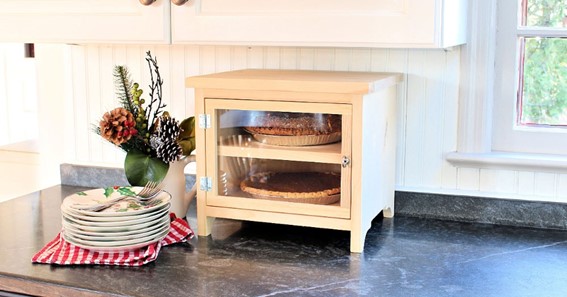Are you curious to know what is a pie safe? You have come to the right place as I am going to tell you everything about a pie safe in a very simple explanation. Without further discussion let’s begin to know what is a pie safe?
What Is A Pie Safe?
In the realm of culinary traditions and treasured heirlooms, the pie safe stands as a symbol of a bygone era when homemade pies were the centerpiece of many kitchens. This traditional piece of furniture not only served as a storage solution for perishable goods but also added a touch of beauty to the heart of the home. In this blog post, we’ll delve into the fascinating world of the pie safe, uncovering its origins, purpose, and enduring appeal that continues to captivate enthusiasts of culinary history and design.
A Glimpse Into The History Of Pie Safes:
The pie safe, also known as a pie cabinet or pie cupboard, originated in the United States during the 19th century. As kitchens lacked modern refrigeration methods, these sturdy wooden cabinets were designed to protect pies, baked goods, and other perishable items from insects, dust, and humidity while allowing proper airflow to prevent spoilage. Pie safes were commonly found in homes across rural America, becoming an essential part of preserving food in a time before refrigeration became commonplace.
Purpose And Features Of A Pie Safe:
The primary function of a pie safe was to provide a cool and secure environment for storing freshly baked pies. The cabinets were typically constructed with punched or perforated tin panels on the doors and sides, allowing air circulation while keeping pests at bay. The punched tin panels not only served a functional purpose but also added an ornamental touch to the furniture, often featuring intricate designs and patterns.
Design And Craftsmanship:
Pie safes were crafted with careful attention to detail, showcasing the skill and craftsmanship of the artisans who created them. The cabinets were typically made of solid wood, such as oak, pine, or walnut, and featured dovetail joinery, sturdy hinges, and decorative hardware. The punched tin panels were carefully installed, showcasing patterns like stars, geometric shapes, or intricate floral motifs, adding both functionality and aesthetic appeal to the piece.
Evolving Styles And Variations:
Over time, the design and styles of pie safes evolved to reflect changing tastes and trends. While the classic punched tin panels remained a staple, variations included solid wood doors, mesh wire panels, or even glass inserts, allowing the stored items to be displayed while still maintaining protection. Additionally, pie safes were often passed down through generations, leading to the incorporation of personal touches or regional influences, making each piece unique.
Collecting And Decorating With Pie Safes:
Today, pie safes hold a special place in the hearts of collectors and enthusiasts of antique furniture and culinary history. These timeless pieces not only offer storage functionality but also serve as decorative accents, infusing a sense of nostalgia and charm into modern interiors. Whether used to display treasured family heirlooms or repurposed as unique storage solutions in kitchens or dining areas, pie safes add a touch of history and character to any space.
Conclusion:
The pie safe stands as a testament to the ingenuity and resourcefulness of previous generations in preserving and safeguarding their culinary creations. With their intricate craftsmanship and functional design, these beloved pieces of furniture continue to capture the imagination of those who appreciate both culinary heritage and the beauty of traditional craftsmanship. So, the next time you encounter a pie safe, take a moment to appreciate its timeless allure and the stories it holds within its carefully crafted.
Gather More Information About such Things By Visiting Mesbrand
FAQ
What Is The Purpose Of A Pie Safe?
The pie safe, sometimes referred to as a pie cabinet, pie safe cupboard, or a pie chest, is a piece of furniture typically used to store pies. In the past, some people also stored meat, perishables, and other items inside of their pie safes. Today, pie safes are more often used to store linens or even kids’ toys.
What Is The Difference Between A Pie Safe And A Jelly Cabinet?
A pie safe is a safe-like kitchen cupboard with two doors that feature pierced holes. These holes allow pies to safely cool when placed inside the cupboard. A jelly cupboard is a kitchen cupboard that features two doors and two drawers.
What Is The Origin Of The Pie Safe?
Origins. It is believed that the pie safe was first introduced in the United States in the 1800s by German immigrants who would come to be known as the Pennsylvania Dutch. Word spread quickly about the new storage solution that protected baked goods.
What Is An Amish Pie Safe?
The Amish Traditional Pie Safe will warm your kitchen, dining room, or pantry with an inviting, rustic style. Pie safes were originally used for storing pies, cakes, and bread and are also called pie cupboards, pie chests, or kitchen safes.
I Have Covered All The Following Queries And Topics In The Above Article
What Is A Pie Safe Cabinet
What Is The Difference Between A Pie Safe And A Jelly Cabinet
What Is A Pie Safe Used For
What Is A False Pie Safe?
What Is Best To Put On A Old Pie Safe Old Engish
How Old Is My Pie Safe
Pie Safe Cabinet
Pie Safe Furniture
Pie Safe 1800-1899 Antique
Amish Pie Safe
What Is A Pie Safe
Why did people have pie safes
What does a pie safe look like
